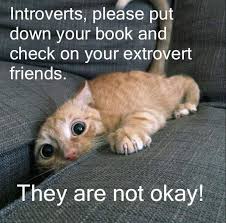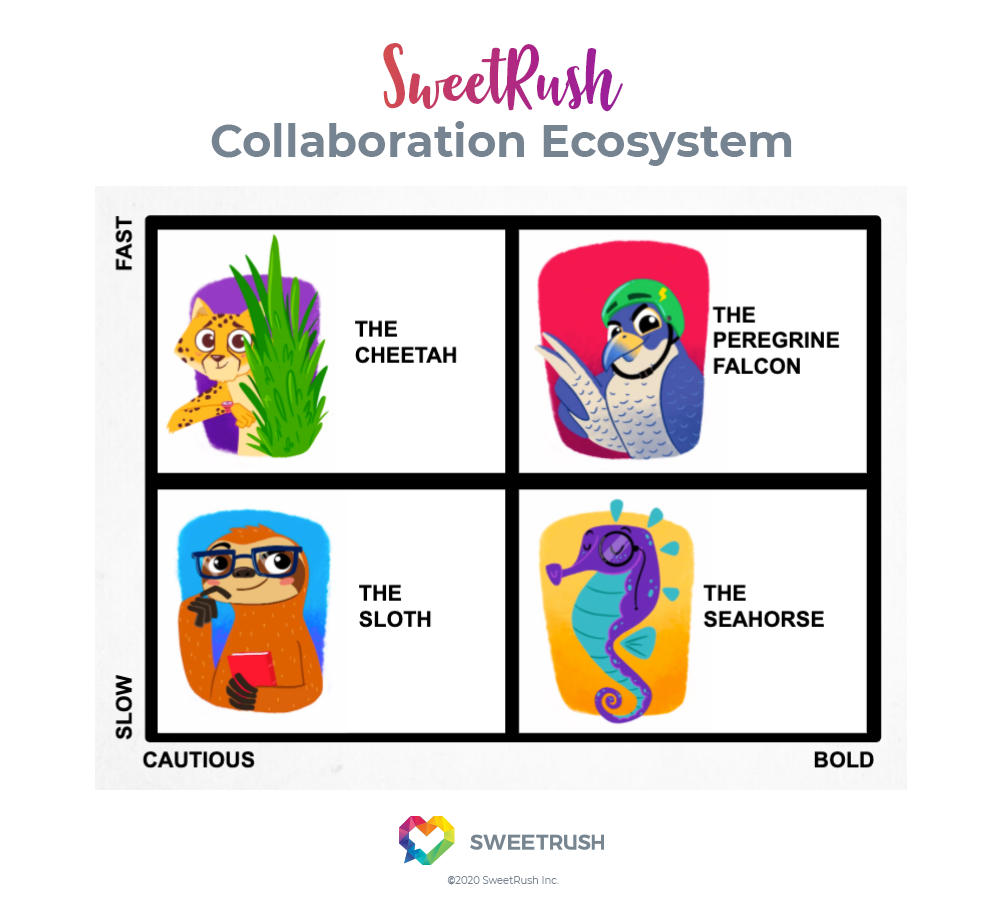How is your team handling remote work and virtual collaboration? In this article, SweetRush’s Director of Instructional Design, Clare Dygert, shares proven techniques for enhancing remote team collaboration from her experience managing SweetRush’s 100% virtual Instructional Design team.
A couple of memes are making the rounds.
“I’m an introvert. I’ve been training for social distancing my entire life.”
‘social distancing’ please i’ve been training for a pandemic my entire life introverts rise up we’re finally valid
— Daniel Howell (@danielhowell) March 11, 2020
“Check on your extroverts. They are NOT OK.”

After a few weeks of getting used to managing a virtual team, your initial worries about knowing if anyone is working or not will begin to subside. You’ll see a return to productivity as folks figure out how to manage the kids being home, master the mysteries of virtual meeting software, and adjust to the mental bandwidth issues that come with this strangely reordered world we find ourselves in.
Now you may begin to notice a new issue. Teams are made up of a variety of personality types on the extrovert/introvert scale. You may notice that the louder voices are dominating in collaboration meetings, and the softer voices aren’t being represented. In person, you could monitor and make a space for someone who is less willing to interrupt or push into the conversation, but you may find this very difficult in a virtual environment.
Here are some practical ideas to help you with virtual collaboration.
Set an agenda.
Many teams have regular meetings with open agendas to discuss whatever needs to be talked about. Use a shared document to solicit agenda items before the meeting. We also use the document to make notes and record decisions as we move through the items at the meeting. By making it open and shared, everyone can have items discussed.
Check in.
Start meetings by going around and asking people to “check in”—in other words, share how they are feeling at that moment. When we do this, we are asking teammates to comment on how they are doing, emotionally and physically, not make a status update on some previously determined action item. This puts a focus on the human side of things and makes us aware of the emotional state of those around us. It also serves as a “warm-up” for talking. This is especially helpful for the quieter among us.
Set ground rules at the beginning of the collaboration meeting.
Ground rules can be anything from agreeing to put questions in the chat area to holding comments until the end of a presentation. Whatever they are, state the ground rules up front and out loud. Verbally agreeing how you are going to operate is kind of a mindfulness thing. It puts everyone on the same page and communicates to your team that how we communicate is as important as what we accomplish. This definitely invites remote team collaboration and participation.
Step up, step back. One of our common ground rules is “step up, step back.” This rule asks people to notice how much they are contributing. If they are talking a lot, then they should step back and be quiet so others can have the floor. If they notice that they have said little, then they are asked to step up and speak when the floor becomes available.
Yes, and… Another technique you can use (which you could set as a ground rule during brainstorming) is to use the phrase “Yes, and…” when you start speaking, essentially adding on to the previous person’s idea. This is a technique often used in improvisation—it helps keep the ideas flowing. For example, if my colleague says, “We could use recyclable materials in the packaging,” I could answer, “Yes, and biodegradable items whenever possible.”
Consider your virtual collaboration ecosystem.
We have found that how quickly people generate ideas and how boldly they share those ideas varies, particularly during remote team collaboration. But it’s important to remember that the quality of ideas doesn’t depend on how fast or slow ideas come, or how boldly or cautiously they are shared. In leading virtual teams, we have to create space for people to share in the way they’re most comfortable.
So how do we help the fast, bold people understand and wait for the quiet, slower people? We find that simply understanding this to be true is the first step, and we use our collaboration ecosystem to illustrate this reality.
The way we do this is to ask individuals to identify and share their collaboration “spirit animal.” The graphic below illustrates our four spirit animals. We ask our remote team to first think about how quickly they generate ideas (that’s the X-axis). Then we ask them to think about how bold they are at sharing ideas (the Y-axis). If they identify as a fast idea-generator and a cautious sharer, their spirit animal is the Cheetah. A slow idea-generator and bold sharer is the Seahorse.

SweetRush’s “collaboration ecosystem” supports virtual collaboration by helping people identify and self-manage their participation according to their idea-sharing speed and boldness!
The spirit animal may change in different situations. If I know people, I might be more bold. If I’m collaborating with a new virtual team, I might be more cautious. I like to think of it as “polite.” 🙂
The collaboration ecosystem helps remote team members self-manage their participation. If you know you are a Sloth in the group, then perhaps you will suggest that collaboration take place over multiple days, so you have time for some “shower thinking.” Or, you start thinking about ideas before you join others in a virtual collaboration session.
We have found that just by acknowledging that not all smart, productive people think the same that we make space for everyone to contribute. Which naturally makes our virtual collaboration better. We also have seen these personas begin to creep into our shared language too—“Whoa there Falcon, let’s give some space for the Sloths among us!” “I’m feeling very Seahorse today!”
Structure feedback.
We also use “rounds” when we are managing virtual teams to structure our feedback and conversation about a proposed idea.
To use rounds:
- First an action or solution is proposed and fully explained by its authors.
- Then, each person, in turn, may ask a clarifying question, which the proposers answer.
- Then, each person may give feedback using the “I like, I like, I wonder” formula. For example, “I like the way you addressed the learners’ concerns about the training time. I like how you’ve structured the learning objectives. I wonder if there could be additional opportunities to practice.”
- The proposer doesn’t respond, and no one can add to the feedback until it is in their turn and only by using the “I like, I like, I wonder” formula.
We have found this structure to be almost magical in how it focuses feedback and keeps us from going down rabbit holes of discussion. And the quiet voices have the same opportunity to share feedback as the louder voices.
Using these virtual collaboration techniques may feel awkward and stilted at first. But so does bringing on new communication software, dealing with the sound of kids and pets in the background, and the stress of working at your kitchen table on a slightly unreliable internet connection. You will be surprised at how quickly these things become a natural part of the language of your virtual team. And at some point in the future, you may agree that incorporating new practices that help you work more collaboratively was a silver lining in an otherwise very dark cloud.
Clare Dygert is SweetRush’s Director of Instructional Design. Reach out to her on LinkedIn at https://www.linkedin.com/
Read more about leading remote teams and virtual collaboration:



